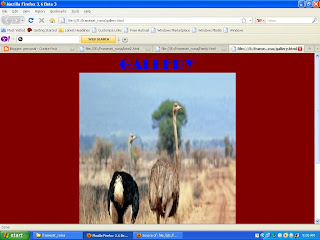<html>
<head>
<title>
title>
head>
<frameset rows="x,*" cols="y,*">
<frame name="1" src="lone1.html" marginwidth="50" marginheight="50" scrollling="
auto"
frameborder="0">
<frame name="2" src="mainpage.html" marginwidth="50" marginheight="50" scrollling="
auto"
frameborder="2">
<frame name="3" src="introc.html" marginwidth="50" marginheight="50" scrollling="
auto"
frameborder="2">
<frame name="4" src="introd.html" marginwidth="50" marginheight="50" scrollling="
auto"
frameborder="2">
html>
<html>
<head>
<body>
<body bgcolor="maroon">
<a link href=
"lone2.html"rel="stylesheet"type="text/html">HOMEa>
<a link href=
"family.html"rel="stylesheet"type="text/html">FAMILYa>
<a link href=
"gallery.html"rel="stylesheet"type="text/html">GALLERYa>
<a link href=
"facts.html"rel="stylesheet"type="text/html">FACTSa>
<br><font face="broadway"size="+3"color="blue">Ostrichesfont>
<h1><font face="arial black"color="#abc123">Native to Africa, the ostrich,
Struthio camelus, is the largest living species of bird, growing to a height of
approximately 2.4 m (8 ft) and a weight of 150 kg (330 lb). Although flightless,
the ostrich can run at speeds as high as 65 km/hr (40 mph). Highly adaptable,
ostriches can be found living in mountainous areas, open savanna, or sandy desert
plains. They have omnivorous feeding habits, eating grass, the foliage of trees
and bushes, and any small invertebrate and vertebrate animals they can chase down.
h1>font>
<center><img src="pic.png">center>
body>
html>
<body bgcolor="maroon">
<font face="broadway"size="+3"color="blue">INTRODUCTIONfont>
<br><font face="arial black"size="+2">Bird, animal with feathers and wings.
Birds are the only animals with feathers, although some other animals, such
as insects and bats, also have wings.
Nearly all birds can fly, and even flightless birds, such as ostriches and
penguins, evolved from flying ancestors.
Birds are members of a group of animals called vertebrates, which possess
a spinal column or backbone. Other vertebrates are fish, amphibians, reptiles,
and mammals.
Many characteristics and behaviors of birds are distinct from all other
animals, but there are some similarities. Like mammals, birds have four-
chambered hearts and are warm-blooded—having a relatively constant body
temperature that enables them to live in a wide variety of environments.
Like reptiles, birds develop from embryos in eggs outside of the mother’s body.
Birds are found worldwide in many habitats. They can fly over some of the
highest mountains on earth as well as both of the earth’s poles, dive
through water to depths of more than 250 m (850 ft), and occupy habitats
with the most extreme climates on the planet, including arctic tundra and
the Sahara Desert.Certain kinds of seabirds are commonly seen over the open
ocean thousands of kilometers from the nearest land, but all birds must come
ashore to raise their young.Highly developed animals, birds are sensitive and
responsive, colorful and graceful, with habits that excite interest and inquiry.
People have long been fascinated by birds, in part because birds are found in
great abundance and variety in the same habitats in which humans thrive.
And like people, most species of birds are active during daylight hours. Humans
find inspiration in birds’ capacity for flight and in their musical calls.
Humans also find birds useful—their flesh and eggs for food, their feath
ers for warmth, and their companionship. Perhaps a key basis for our rapport
with birds is the similarity of our sensory worlds: Both birds and humans rely
more heavily on hearing and color vision than on smell. Birds are useful
indicators of the quality of the environment, because the health of bird
populations mirrors the health of our environment.The rapid decline in bird
populations and the accelerating extinction rates of birds in the world’s
forests, grasslands, wetlands, and islands are therefore reasons for great
concern.<br>font>
<html>
<head>
<body>
<body bgcolor="maroon">
<center><font face="broadway"size="+5"color="blue">FAMILYfonts><br>
<font face="broadway"size="+5"color="blue">
Ostriches have the largest eyes of all land animals and
have excellent eyesight.A special membrane protects the
eye from dust and sand. They can deliver powerful<br>
kicks for defense against predators. Ostriches sometimes sit
with their necks extended on the ground. This posture
may have given rise to the myth that ostriches hide their<br>
heads in the sand. They usually sleep with their neck and<br>
head tucked undera wing. They can live for 20 to 30 years<br>
in the wild, and up to 40 years in captivity.<br>
body>center>
html>
<body bgcolor="maroon">
<center><font face="broadway"size="+5"color="blue">GALLERYfont>
<br><img src="pic2.png"width="500" height="750"/>center>
<html>
<body>
<body bgcolor="maroon">
<center><table border="1" cellpadding="4" cellspacing="4" width="50%"
td bgcolor="violet">
<tr>
<td><font face="broadway"size="+5"color="blue"><blink><marquee>FACTStd>
tr>td>
table>font>blink>marquee>
<b>Tb>hey walk on two broad toes with large claws (most birds walk
on three forward-facing
toes).<br> Their feathers have a shaggy appearance and are not waterproof
—ostriches lack the
special<br>preen gland many other birds use to oil their feathers.
Mature male ostriches are
black,<br>with white wings and tail. Females and immature young are
a dull grayish brown. Hair
like<br>feathers cover their necks and form large black lashes around
their eyes. Their upper
<br>legs are bare, with scales on their lower legs and toes. Their short
wings are sometimes<br>
spread when running and in mating displays.Ostriches primarily feed on
plant material such<br>
as fruits, seeds, leaves, and shoots, but sometimes eat insects and lizards.
They swallow<br>
stones to help grind food in their gizzards. Adapted to dry areas, they can go
with drinking<br>
water for long periods, getting moisture from vegetation.Males hiss and roar
when challenging<br>
rivals for females. They also make a deep booming sound to assert their territory,
and perform<br>
elaborate mating displays, using their wings like fans. A single male breeds
with a group of<br>
three or four females. The females all lay their yellowish-white eggs together
in a large depression<br>
in the sand used as a communal nest. The eggs weigh about 1.4 kg (about 3 lb)
each and have a volume<br>
of about 1.4 liters (about 3 pt), equivalent to 24 chicken eggs. The male sits
on the eggs at night,<br>
and the females incubate them by day. The incubation period is about 40 days.
When the eggs hatch,<br>
the chicks will follow the adults for protection.Ostriches belong to an ancient
group of flightless<br>
birds called ratites that includes rheas in South America, emus in Australia,
cassowaries in New Guinea,<br>
and kiwis in New Zealand, as well the extinct moas from New Zealand and the
elephant birds on Madagascar.<br>
Ratites have flat breastbones, unlike the keeled breastbones found in many
other types of birds. The oldest<br>
fossils of ostriches date to around 40 million years ago during the Eocene Epoch.
Ostriches have apparently<br>
changed little since that time. Around 5 million years ago they lived in areas
that are now parts of Russia,<br>
India, and China, but became extinct.center>
body>
html>










